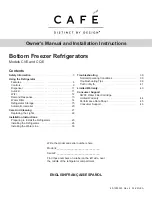
– 20 –
The evaporator fan utilizes a permanent magnet, 4-pole, DC motor that operates at three different
speeds: high, medium, and low. The speed of the fan is controlled by the voltage output from the
primary control board. Voltage output from the control board to the fan is 12.6 VDC; however, in
order to regulate the speed of the fan, the control board uses pulse width modulation (PWM) during
low speed and medium speed operation. When operating in low and medium speed, voltage is
sent in pulses (much like a duty cycle) as opposed to an uninterrupted flow. This pulsing of 12.6
VDC produces effective voltage being received at the motor, which is the equivalent to a reduction
in voltage. Fan speed will be selected and maintained by the control board regulating the length and
frequency of the 12.6-VDC pulse.
One complete revolution of the motor is comprised of all 4 poles. To determine the rpm of the fan:
Measure the frequency being applied to the motor. Multiply this number by 15 (60 seconds divided
by 4 poles). For example, a frequency measurement of 200 Hz multiplied by 15 would show a fan
speed of 3000 rpm (15 x 200 = 3000). Temperature may cause some fan speed variation. Fan
speed may vary +/- 5%, depending on the temperature, with higher temperatures causing slightly
higher speeds.
High Speed (12 VDC measured)
Medium Speed (8 VDC measured)
Low Speed (4 VDC measured)
EVAPORATOR FAN SPEEDS
12 VDC
8 VDC
4 VDC
12 VDC
0 VDC
0 VDC
0 VDC
12VDC
12 VDC
GEA01139
















































